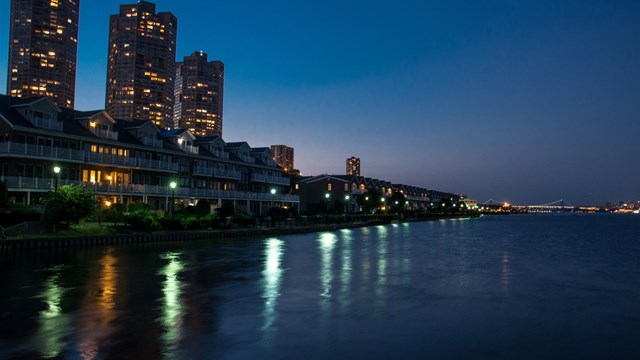As its population reaches 67,000, Hudson County's township of Union City is fast becoming an attractive alternative for those who work and play in Manhattan.
Bordered on the south by Jersey City, on the north by West New York, on the west by North Bergen, and on the east by Weekhawken, Union City may not often be talked about in the same sense as Gold Coast towns like Jersey City and Hoboken, but residents say their town offers a similar quality of life, and some would argue even better convenience to the city.
"It's still close to Manhattan," says Bob De Ruggiero, president of Union City's Robert De Ruggiero Realtors. "It doesn't have a waterfront, but it does have a lot of new construction going on and prices relatively cheaper compared to downtown Jersey City or Hoboken. It could be as much as a $500 to $700 a square-foot difference."
"Union City is growing, with lots of positive changes," says Charleen Martinelli, a broker with Coldwell Banker. "Young families are able to stay, instead of having to run to the suburbs. It's an urban lifestyle that is very popular with young people."
Early History
Union City was originally inhabited by the Lenni Lenape tribe, but was later settled by the Germans in 1685, when they moved across the Hudson River from New York in search of affordable land and open space.
"It resulted from West Hoboken and Union Hill merging in June of 1625," says city historian Gerard Karabin. "Some records indicate that Hudson County was first settled in 1614 when the Dutch established a trading fort near what is now Union City, but it was not until the mid-1800's that the city began to develop."
That's when a group of German-Americans began to build homes in the Union Hill section (32nd to 49th streets) and the city grew quickly, hitting 60,000 residents by 1920. However, that number shrank to just 53,000 by 1960.
"About that time there was a number of Cuban refugees who came to Union City, and so the population rose again," says town librarian Rita Mann. "You can still see that influence today."
After the Cubans came, other ethnic groups followed. Many South Americans, Central Americans, Haitians, Asian Indians, Koreans, Arabs and many others called Union City home. After World War II, Union City attracted a large Hasidic Jewish community, who have become very much a part of the Union City tapestry.
"That's why there is great diversity in Union City—each group has left a bit of their culture," says Karabin. "Union City still serves as a place for immigrants to come to because or its proximity to New York City at a more affordable place to live."
The current mayor of Union City is Brian P. Stack, who became mayor in 2000 after a recall election forced the resignation of then-mayor Raul "Rudy" Garcia. Stack also serves on the Board of Commissioners, on the Hudson County Board of Chosen Freeholders, and in the New Jersey General Assembly.
Street Sense
The easternmost streets of Union City, in particular Mountain Road and Palisade Avenue, boast some impressive views of neighboring Weehawken, Hoboken and the New York City skyline. In the aftermath of the September 11 attacks, many Union City citizens stood in the courtyard of the Union City Boxing Club to view the event's aftereffects. A piece of wreckage from the attack was used to create a monument that now stands in that courtyard.
"There is a lot of history in the streets," says Karabin. "Palisade Avenue was home to many prominent figures and Lewis Street was a hub of activity."
When first settled in the 1880s, the primary commercial area of Union City was Palisade Avenue. An influential citizen named Henry Kohlmeier who lived on this street objected to the noise created by horse-drawn public coaches, and led to the route being transferred two blocks west to what is now Bergenline Avenue, (known then as Lewis Street).
Bergenline runs parallel to Palisade Avenue and remains the city's main commercial thoroughfare. Currently the longest commercial avenue in the state, boasting over 300 retail stores and restaurants, Bergenline runs through not only the entire length of Union City from north to south, but also through West New York, Guttenberg and North Bergen, making it the main commercial strip for Northern Hudson County. This is known to residents as "Miracle Mile."
The Condo and Co-op Scene
According to the town's website www.ucnj.com, housing stock tends to be older, but there is some new construction throughout the city. Recently, developers have expressed interest in several parcels of property available for construction of residential units, and are seeking permission from town officials to build a number of new residential and mixed-use structures.
"This is a condo town, and there's a lot of new construction going up," says Martinelli. "We have a 20-unit complex going up called Vista Commons, for example. It only went on the market a few months ago, and we only have a few left. These are very nicely upgraded units modestly priced between $300,000 to mid-$400,000."
Then there's Central Plaza on 9th Street, with units starting in the mid-$200,000's—parking included.
Like most condos in the area, both these units offer two-bedroom units, as there is little call for one-bedroom condos in Union City. Considering that one-bedrooms in Hoboken are regularly priced around $400,000, the Union City condos are quite a deal.
"Obviously this is a lot cheaper than New York City—but it's also less than in the neighboring towns," says De Ruggiero. "It's a good alternative to the historic sections of Hoboken and Jersey City. Prices are usually $300 to $350 a square-foot on average."
Some condos offer New York views along the Eastern part of town on Palisade Avenue, and these go for a little more.
There are two co-op buildings in Union City. The Doric and Troy Towers are both high-rise co-ops that were built in the late 1960s and early '70s.
"When you are talking about those two co-op buildings, one-bedrooms go for around $200,000 to $250,000 and the two-bedrooms are around $300,000 to $450,000 and up," Martinelli says. "Sometimes you get a view—and those are obviously the more expensive units." A downside to these co-ops, he says, though, is that residents will need to rent parking, which could be costly.
Sale properties are on the market a lot longer than they were last year, with the average condo staying near 100 days. This hasn't hurt the prices, though.
"You don't see as many bidding wars as you did before, but prices are still up 26 percent—although that's starting to flatten out," De Ruggiero says. "The total gross number of sales are down 12 percent for the first few months this year, but we predict the pendulum will swing back in the next quarter."
The Quality of Life
The face of the area is a nice blend of families and professional working people, many with double incomes.
"We're seeing very mixed demographics," Martinelli says. "It still has the local Main Street-type shopping. You don't have to drive to a mall like you do in the suburbs. Architecturally, all the new stuff is beautiful with upscale lobbies, catering to a very modern taste."
"Union City has a strong Latino influence and a very vibrant culture," De Ruggiero adds. "The main shopping district is very strong and thriving."
Union City also has an excellent transportation system with the newly created light rail that connects to the PATH, ferry and river crossings. The light rail station was opened of February of this year and links the densely populated communities with employment, educational and recreational destinations along the Hudson waterfront.
"This light rail system is improving the quality of life for thousands of New Jersey residents by providing better access to jobs and educational opportunities, as well as contributing to continued economic development and the transformation of the Hudson County waterfront," said New Jersey Governor Jon C. Corzine at the opening of the Bergenline station.
Union-izing Forces
In recent years Union City has caught on to the redevelopment that was happening in Hoboken and Jersey City, but remains a more affordable place to live than its immediate neighbors.
"The city has a progressive administration, and we are seeing more new developments and older buildings being refurbished or knocked down," says De Ruggiero. "Being this close to Manhattan at this price is a great deal that people better take advantage of soon."
Keith Loria is a freelance writer and a frequent contributor to The New Jersey Cooperator.





Leave a Comment